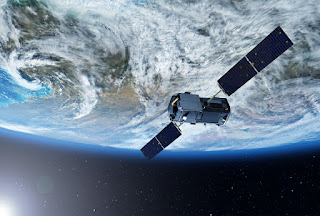10 Piezoelectric Sensor Types Explained
Piezoelectric sensor types are; sonic, ultrasonic, mega-sonic, lead-type, pin-type, pressure, force, accelerometer, mechanical, and electrical sensors.
They are classified and distinguished based on acoustic capability, lead-connection design, and mode of operation.
This article discusses piezoelectric sensor types, as follows;
1). Sonic Sensor (as one of the Piezoelectric Sensor Types)
Sonic sensors are devices used to detect (and characterize) bodies or objects based on acoustic waves or vibrations released from the object.
For sonic sensors, the acoustic waves that can be detected by this piezoelectric device are those which fall within audible range [1].
Sonic sensors are used for a variety of purposes, among which geologic exploration is a prominent example. The sensor may operate by emitting acoustic signals which are reflected back to the device on collision with objects in their path.
When these reflected signals are received, their characteristics can be analyzed to derive information about the objects that have been detected.
2). Ultrasonic Sensor (as one of the Piezoelectric Sensor Types)
Ultrasonic piezoelectric sensor is used to detect acoustic waves that vibrate at very high frequencies above the audible range; which is typically above 20 kHz [2].
This category of acoustic waves is often referred to as ultrasound.
Piezoelectric ultrasound works on the basis of the piezoelectric effect; whereby electricity is generated as a result of mechanical (vibratory) stresses created when acoustic waves interact with a material.
The high-frequency operation of ultrasonic piezoelectric sensors, makes them capable of being utilized under a broad range of conditions, and for a variety of purposes.
It is important to note that ultrasonic sensors differ from ultrasonic transducers; which are capable of generating their own ultrasound waves.

3). Mega-sonic Sensor
Mega-sonic sensors operate based on the same principles as sonic and ultrasonic sensors, but are designed to detect acoustic waves or vibratory stresses at high frequency than ultrasonic waves.
These acoustic waves are called mega-sonic waves, and may vibrate at frequencies that exceed 1000 kHz.
4). Lead-type Sensor
Lead-type sensor is a type of piezoelectric sensor that uses lead materials like lead zirconate titanate (PZT) as the main piezoelectric material.
The piezoelectric material in this sensor is usually connected to electric cables which help with current transmission.
5). Pin-type Sensor (as one of the Piezoelectric Sensor Types)
Pin-type piezoelectric sensor also uses lead compounds as the main piezoelectric materials.
However, the connection design of this type is slightly different from that of lead-type sensor. In place of cables, metal pins are used for current transmission.
Pin-type and lead-type sensors are generally equal in performance, principle and capacity.
6). Pressure Sensor
Piezoelectric pressure sensor is a type of piezoelectric sensor that is used to evaluate changes in dynamic pressure conditions within a given environment, medium or body.
The accuracy of this type of piezoelectric sensor is dependent on its sensitivity to mechanical stress. Its operation is based on the linear proportional relationship between pressure and electricity generation (estimated in terms of current and voltage).
7). Force or Load Sensor (as one of the Piezoelectric Sensor Types)
Piezoelectric force sensor is a type of piezoelectric sensor that is used specifically to detect and estimate strain, stress, or mechanical load.
This type of sensor is most relevant in situations or events involving significant amounts of force.
The operation of piezoelectric force sensor is based on the generation of electrostatic charges from piezoelectric materials when they are subjected to stress.
8). Accelerometer Sensor
A piezoelectric accelerometer measures or detects motion through the mechanical changes that occur as a body experiences changes in speed (also known as acceleration).
Alternatively referred to as a piezoresistive accelerometer, it works by analyzing force dynamics like stress and vibration/harmonic motion, which are set off as acceleration or any significant mechanical process, occurs.
The piezoelectric accelerometer sensor is often used for shock testing and pulse measurement or evaluation. Like other types of piezoelectric sensors, it depends on the piezoelectric effect, or changes in electric charge dynamics with changes in stress distribution, for all its functions.

9). Mechanical Sensor (as one of the Piezoelectric Sensor Types)
A piezoelectric mechanical sensor is used to detect changes in mechanical properties or variables like force and speed or direction of motion.
10). Electrical Sensor
An electrical piezoelectric sensor uses the piezoelectric effect to analyze the supply and flow of current through a conductor or energy management system.
Conclusion
Piezoelectric sensor types are;
1. Sonic Sensor
2. Mega-sonic Sensor
3. Ultrasonic Sensor
4. Lead-type Sensor
5. Pin-type Sensor
6. Pressure Sensor
7. Force or Load Sensor
8. Accelerometer Sensor
9. Mechanical Sensor
10. Electrical Sensor
References
1). Kuwano, T.; Kaneta, H.; Satoh, K.; Nishikawa, J.; Murakami, S.; Tateno, T. (2020). “Developing a Frequency‐selective Piezoelectric Acoustic Sensor Sensitive to the Audible Frequency Range of Rodents.” IEEJ Transactions on Electrical and Electronic Engineering 15(12):1816-1823. Available at: https://doi.org/10.1002/tee.23260. (Accessed 6 December 2022).
2). Seo, W.; Im, S.; Lee, G. (2021). “Characteristics of the Received Signal of an Ultrasonic Sensor Installed in a Chamber with Micro-Leakage.” Mechanical Sciences. Available at: https://doi.org/10.5194/ms-12-1051-2021. (Accessed 6 December 2022).





